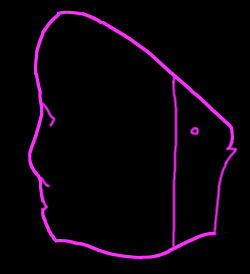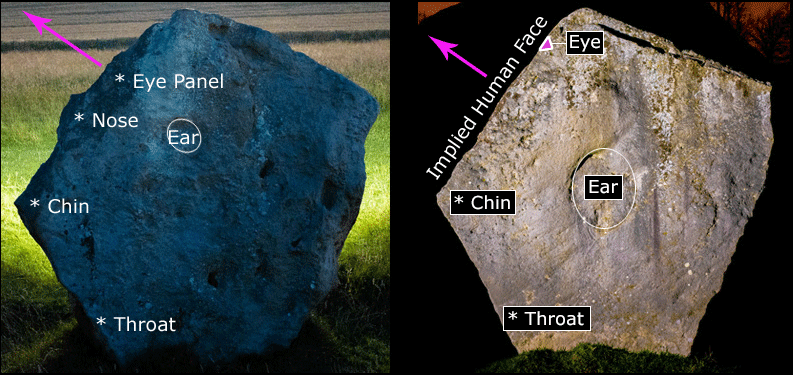|
Twin Spirits Of Avebury And Their Dual Symbol

I. Introducing The Dual Symbol
Just as the Christian people have their Crucifix, and the Jewish people have their Star Of David, I suggest that the Avebury peoples have left us their own fundamental religious symbol, a symbol so integral to the purposes of Avebury that it was incorporated into the earliest phase of West Kennet Long Barrow, and was hacked multiple times into the very Entrance stones of the main henge. I call this symbol the "Dual Symbol" - you can see this on several Avebury monoliths, we are looking for a coherent paired symbol, comprising a large, blocky, probably male human profile, counterbalanced by a smaller, pointed/beaked face looking in the opposite direction:
 
Dual Symbol, south elevation, Swindon Diamond Stone
Of course the details vary according to individual iterations of the symbol on different monoliths, but the repeated basic themes of the "block" and "beaked" faces show their great importance to Avebury's neolithic religion. I should make it clear that Avebury monoliths were usually intended to contain multiple meanings requiring the creation of multiple carvings. Just because a monolith contains a dual symbol that does not therefore mean there won't be other carvings adjacent.
II. Where Does The Dual Symbol First Appear?
I believe that in general many of Avebury's carvings at the main Henge and Avenue were based on the earlier examples still on display at West Kennet Long Barrow, a stunning monument created by the Windmill Hill people more than five and a half thousand years ago. Inside the barrow's main chamber, at the extreme west end, stands Stone 21. This stone is crucial because the theme clearly on display here is of opposed larger human profile juxtaposed with a smaller, pointed face looking in the opposite direction - this is the first dual symbol I know of. Here is a sketch of this stone, based on Professor Meaden's drawing on p104 of his "Secrets" book, however I have added the details of the right profiled face myself:

Below I show photographs of the left and right profiled faces on this stone:
I believe that this dual theme was reproduced on several Avebury stones in later times as you will see particularly clearly in the images A to D below. The only obvious changes in the design over time was that in the hands of the later Beaker people the animal face of our Stone 21 evolved into a shaper, beakier icon without the open mouth.
III. Regular Dual Symbols On Diamond Stones - Their Constituent Elements
At Avebury Henge and the Avenue the most striking pairings of the beaked and block faces occurs particularly on diamond or lozenge shaped monoliths. The diamond or lozenge is itself a common motif at Avebury, probably representing sacred feminimity (Meaden, p4 of "Secrets"). The diamond shape was applied (for instance) to the Swindon Diamond Stone and Stone 13b, producing clear corners capable of being carved with horizontally opposed beaked and block faces ((channeling the founding images as described in paragraph II above). For reference the basic outline of the two diamond monoliths is as follows, Swindon Diamond to the left, 13b to the right:
 
These two diamond stones were labouriously and skillfully carved in neolithic times to display their distinctive block and beaked carvings on their left and right profiles. The similarity of placement and sculptural style of the carvings on these elevations is very striking, and clearly not paradolic. You can see the paired carvings on the thumbnails below, figures A and B relate to the south elevation of the Swindon Diamond, figures C and D to the west elevation of Stone 13b:
IV. Further Examples Of Regular Dual Symbols
There is a striking example on Stone 34a of the West Kennet Avenue (image below), which displays an upraised left profiled block face (with a button nose and sharp chin) countered by a right profiled horizontal beaked face with distinctive eye (for a close up view of the beaked face please click here). The block face gazes south, the beaked north:

This monolith has an astounding stylised twin in the form of the main henge's Stone 34 (shown right in the comparison image immediately below), notice the right facing eyes and ear circles on both monuments, also the incredibly similar perimeter shape, this is no mere rorschach effect. This is skillful sculpture, artists shaped these monoliths. In particular, Stone 34 was carved in a surprisingly abstract style, very modern in feel:
|
Stone 34a, West Kennet Avenue
|
Stone 34, North-Western Quadrant
|

Additionally, I have more recently realised that the north elevation of the Swindon Diamond also displays a dual symbol, a particularly important example as this elevation would have faced neolithic pilgrims as they approached the henge from the north. This symbol would possibly have been their first sight of Avebury after their probably arduous journey, block face shown in purple, pointed/beaked one in yellow:

V. Examples of Irregular Dual Symbols
The dual symbols described in paragraphs III and IV above are all quite formal. These symbols appear on regular diamond shaped monoliths. However there are many less formally consistent variants of the dual symbol all over Avebury, they repeat the basic theme but are not hosted on perfect diamond shaped monoliths.
Good examples of irregulars include Henge Stones 12 and 102 (photo here), diagrams below:
 
Stone 09 is another candidate.
Stone 098 is a particularly interesting example, its' north elevation is shown on the diagram immediately below right, the apparently blind beaked face does in fact have a splendid eye labouriously mauled onto the reverse side (photo here):

Another view of the north side of Stone 98:

|